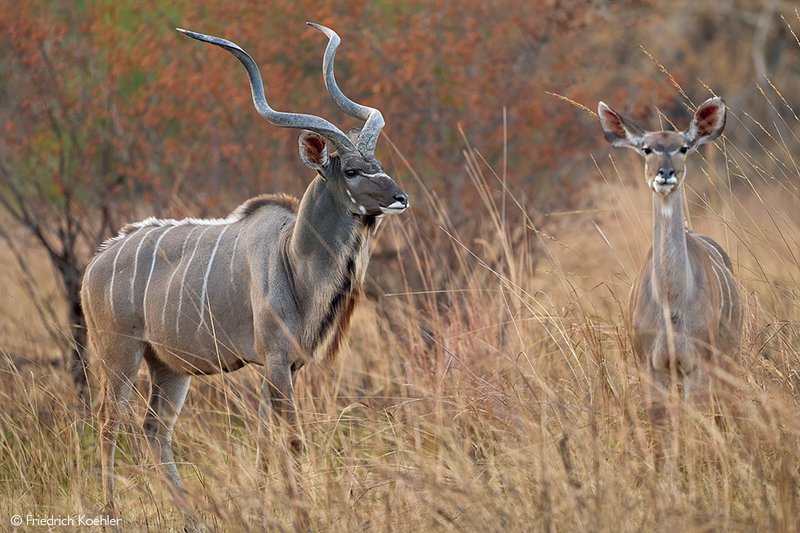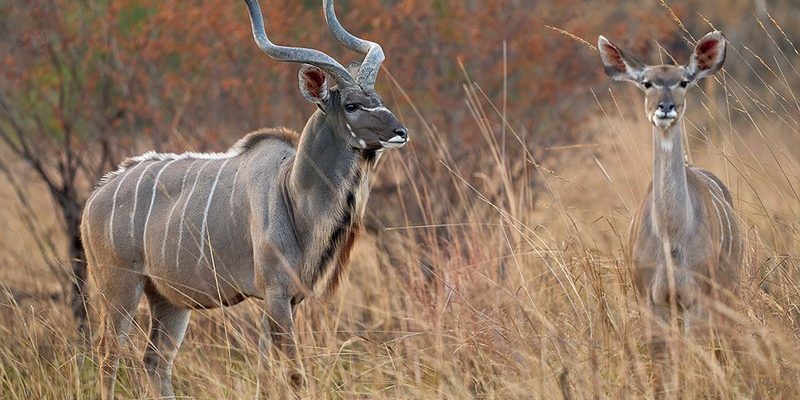
The kudu is part of the Bovidae family, which includes animals like goats and sheep. While many people might recognize them at a glance due to their large size and impressive horns, there’s so much more to their backstory. Understanding their evolutionary journey is like reading a thrilling book—full of twists and turns that give us insight into the survival of species and the delicate balance of ecosystems.
What Are Kudus?
Kudus are large antelopes, primarily represented by two species: the Greater Kudu (*Tragelaphus strepsiceros*) and the Lesser Kudu (*Tragelaphus imberbis*). The Greater Kudu is known for its long, twisted horns that can reach up to 1.8 meters, while the Lesser Kudu boasts horn lengths of up to 90 centimeters. Both species are incredibly agile and can leap about 3 meters high and cover distances of up to 12 meters in a single bound.
Living primarily in eastern and southern Africa, kudus are typically found in bushy areas, savannas, and open woodlands. They are browsers, meaning they primarily eat leaves, shoots, and fruits from trees and shrubs. Their long legs and slender bodies are built for maneuvering through their habitats, making them well-adapted to escape predators.
Honestly, watching a kudu move through the savanna is like witnessing a living work of art. Their beautiful coats, which range from a blue-grey to a reddish-brown, are marked with distinct white stripes. These markings not only add to their beauty but serve a purpose, helping them camouflage in the dappled light of their surroundings.
The Ancestors of Kudus
Kudus belong to a group of animals called ruminants, which are animals that digest their food in a unique way. They have a multi-chambered stomach that allows them to break down tough plant matter. Looking back at their evolutionary history, we find that the ancestors of modern ruminants appeared around 30 million years ago during the Oligocene epoch.
The early ancestors of kudus were likely similar to the modern-day sheep or goats, as they too were part of the Bovidae family. Over millions of years, as they adapted to different habitats in Africa, their physical traits began to evolve. The Greater Kudu, for example, adapted to larger habitats and developed longer legs to help them run faster from predators, while the Lesser Kudu became more suited to denser habitats where agility and camouflage were crucial for survival.
Interestingly, fossils of early bovids have been found across Africa and Eurasia, suggesting that these animals had a more widespread distribution before gradually being confined to their current ranges. This distribution pattern hints at how climate changes and geological events shaped the evolutionary path for kudus.
The Unique Adaptations of Kudus
Kudus have developed several remarkable adaptations that help them thrive in their environments. One of the most notable features is their incredible ability to camouflage. Their striped coats help them blend into the dappled light of the forest or the tall grasses of the savanna. This adaptation is essential for evading predators like lions, hyenas, and leopards.
Their keen sense of hearing and excellent eyesight also play a vital role in their survival. Kudus are prey animals, so being alert is crucial. They often stand still for long periods, using their sharp senses to detect any potential dangers. If they sense a threat, they can leap away with breathtaking speed, zigzagging to confuse predators as they escape.
Another adaptation is their unique social behavior. While males are known to be solitary or form small bachelor groups, females tend to live in larger groups with their young. This social structure provides safety in numbers, which can be crucial when predators are on the prowl. Females often communicate through soft bleats, coordinating their movements and alerting each other of any dangers nearby.
Evolutionary Significance of Kudus in Ecosystems
The evolutionary journey of kudus is not just fascinating for the number of adaptations they’ve made; it also highlights their role in the ecosystem. As herbivores, they play an important part in shaping their environment. By browsing on leaves and shoots, they help maintain the growth of certain plants while preventing overgrowth.
Kudus also serve as prey for numerous carnivores, making them a critical link in the food chain. Their presence supports the populations of predators and contributes to the overall balance of the ecosystem. When kudus thrive, they support a diversity of life around them, creating a healthier environment.
You might be wondering how their evolution affects conservation efforts today. Protecting kudus means preserving the habitats they depend on, which in turn benefits countless other species. Their evolutionary history illustrates the interconnectedness of all life forms, reminding us of the importance of biodiversity and conservation.
Current Threats and Conservation Efforts
Despite their adaptability, kudus face several threats today, mainly due to habitat loss and poaching. As human populations expand, many natural habitats are being converted into agricultural land or urban areas. This has led to a decline in the available space for these majestic animals to roam freely.
Conservation efforts are crucial to ensuring the survival of kudus and their habitats. Various wildlife reserves and national parks have been established to protect these animals and their ecosystems. Programs focusing on community involvement have proven effective, educating locals about the importance of preserving wildlife.
Anti-poaching initiatives also play a significant role. By increasing patrols and implementing stricter laws, conservationists aim to reduce the illegal hunting of kudus. Collaborative efforts that involve different stakeholders, such as governments, NGOs, and local communities, can significantly enhance the effectiveness of these conservation measures.
Here’s the thing: while the plight of kudus may feel overwhelming, every action counts. By supporting conservation organizations and spreading awareness about these animals, we can actively contribute to their ongoing survival.
Interesting Facts About Kudus
Kudus are not just fascinating for their evolutionary history; they also come with some really interesting facts that make them even more remarkable:
- Two Species: As mentioned earlier, there are two main species of kudus—Greater and Lesser. They have different sizes, habitats, and social behaviors.
- Horns: Only male kudus have spiral horns, and these horns can grow up to 1.8 meters long!
- Silent Communication: Kudus are mostly silent but use subtle body language and soft sounds to communicate, especially among females and their young.
- Jumping Skills: Kudus can jump over obstacles up to 3 meters high and can also make long, quick leaps to evade predators.
These facts not only highlight their unique characteristics but also deepen our appreciation for these incredible creatures.
The evolutionary history of the kudu is a captivating tale of adaptation, survival, and ecological significance. From their ancient ancestors to their striking features today, kudus embody the intricate dance of nature. Understanding their journey helps us appreciate the delicate balance of ecosystems and our role in preserving them.
As we move forward, it’s essential to keep the story of the kudu alive, ensuring that future generations can also marvel at these graceful antelopes. By supporting conservation efforts and committing to protecting their habitats, we can help ensure that the legacy of the kudu continues for years to come. So, next time you hear about a kudu, remember the rich story behind them—an evolving narrative that connects us all.

